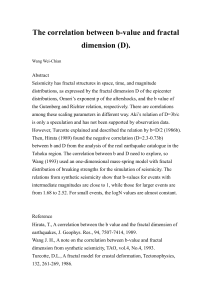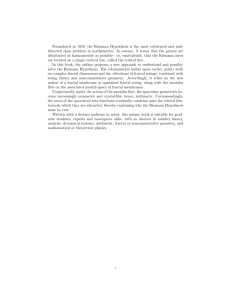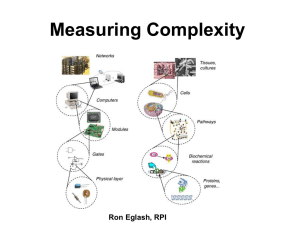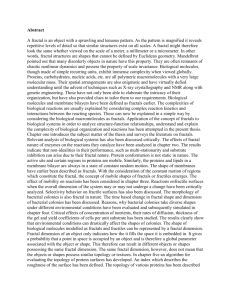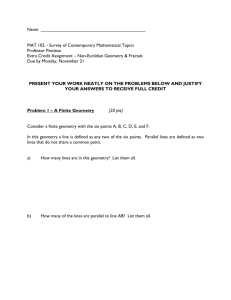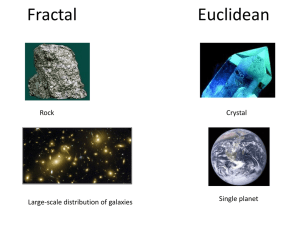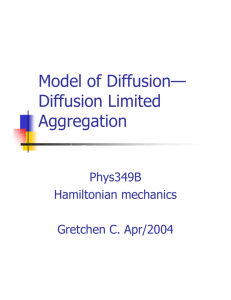Fractals
advertisement
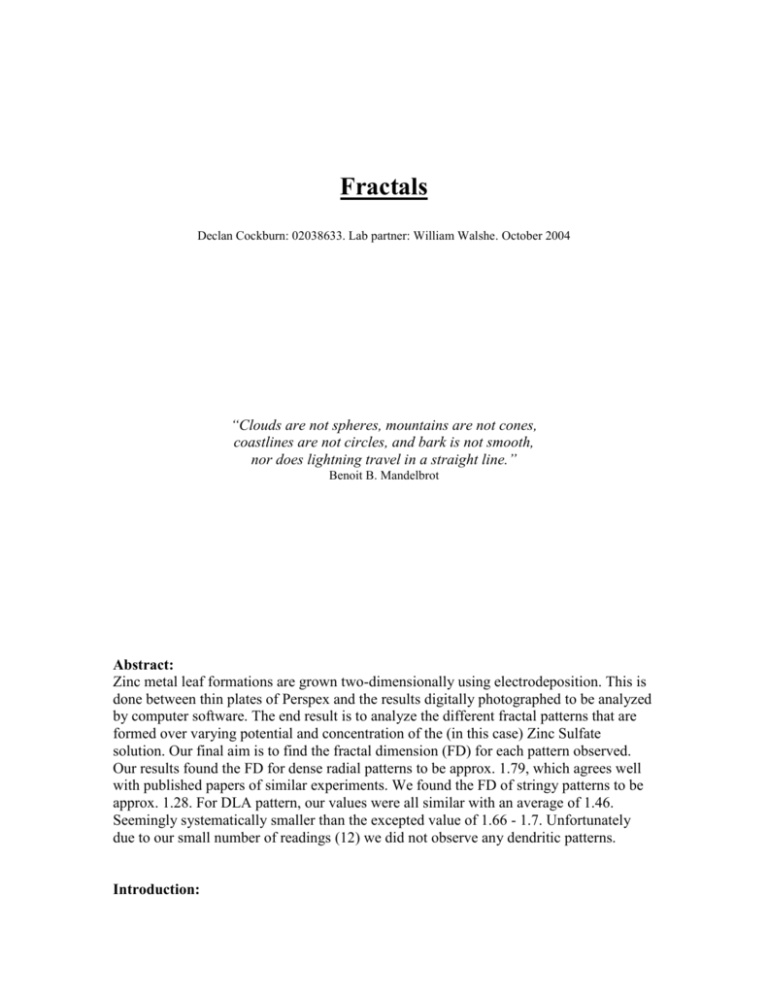
Fractals Declan Cockburn: 02038633. Lab partner: William Walshe. October 2004 “Clouds are not spheres, mountains are not cones, coastlines are not circles, and bark is not smooth, nor does lightning travel in a straight line.” Benoit B. Mandelbrot Abstract: Zinc metal leaf formations are grown two-dimensionally using electrodeposition. This is done between thin plates of Perspex and the results digitally photographed to be analyzed by computer software. The end result is to analyze the different fractal patterns that are formed over varying potential and concentration of the (in this case) Zinc Sulfate solution. Our final aim is to find the fractal dimension (FD) for each pattern observed. Our results found the FD for dense radial patterns to be approx. 1.79, which agrees well with published papers of similar experiments. We found the FD of stringy patterns to be approx. 1.28. For DLA pattern, our values were all similar with an average of 1.46. Seemingly systematically smaller than the excepted value of 1.66 - 1.7. Unfortunately due to our small number of readings (12) we did not observe any dendritic patterns. Introduction: One way to define "fractal" is as a negation: a fractal is a set that does not look like an Euclidian object (point, line, plane, etc.) no matter how closely you look at it. *1 A fractal is basically an object that cannot be completely defined by Euclidian geometry as it has too much structure. Fractals appear often in nature e.g. plant growth and less commonly crystal growth. It is this latter part that we are concerned with in this experiment. While the definition of fractals does not include the necessity for self similarity (the tendency for fractal objects to look the same at different scale magnitudes), it is nevertheless a common property. Zinc metal leaf formations are grown two-dimensionally by electrodeposition. The properties of these “leaves” are generally dependant on the concentration of the (in this case) Zinc Sulfate solution and on the potential applied across the solution. The result is a great variety of structures that fall into four broad but well defined categories: dense radial, diffusion-limited aggregation (DLA), dendritic and stringy. DLA is the morphology of main interest to us. It has an intuitive structure: if one was to imagine particles in random motion, then one particle was to become “sticky” and act as the central particle. Then another particle attaches to this one and becomes “sticky” also. Thus the fractal grows radially outwards and forms self similar branches. See fig 1. Fig 1: An example of a diffusion-limited aggregation (DLA) fractal The fractal dimension is derived from a definition of normal dimension and can be shown quantitatively as: log( N ) Fractal Dimension log( M ) Where N is the number of self similar pieces and M is the magnification factor. Take the Sierpinski triangle (Fig. 2), which has 3 self-similar pieces each with a magnification factor of 2 (or 9 with a mag. factor of 4). Which gives us a fractal dimension of 1.58. The aims of this experiment are to grow zinc fractal crystals across the above range, to digitally photograph them and then analyze them by numerous methods using software. The end result being that we work out fractal dimension. Fig 2: The Sierpinski Triangle Experimental Details: Fig 3: Experimental Setup Firstly the equipment was cleaned. Solutions of ZnSO4 were made up, these ranged in concentration from 1 Molar to 0.01 Molar. The 1M solution was then droppered onto the Perspex base between the anode and the Perspex plate was placed over it with care not to trap any bubbles. The apparatus was set up as above in Fig. 3 with the graphite pencil lead acting as the cathode and the plate clamped down such that there was 0.1 mm thickness of solution between the Perspex (i.e. the thickness of the anode). The Voltage supply was then set on at 4 Volts and the crystals were allowed to grow. A photograph was taken and the image saved. The Perspex was then cleaned and the procedure repeated except this time applying 8 volts across the solution. Then again with 12 volts. The above experiment was repeated for each of our solutions of varying concentration. The next part of the experiment was to allow the computer to analyze the pictures. An image was first resized and converted to black & white. Then any trace of the ring anode was removed as otherwise it would corrupt the analysis. The image was then converted to .pcx format to allow it to be read by the analysis software. Results and Analysis: The images were analyzed by three methods. All of which plot the logs of what they measure and determine the fractal dimension from its slope. Mass Dimension: This counts all the points within a given radius r, Density-density Correlation: c(r) This is the likelihood of finding an occupied point at a distance r from a point on the object. Box Counting: This is the most common method of determining fractal dimension. It uses a mesh drawn over the image and counts the number of squares that contain a portion of the growth, the process then repeated with smaller squares. Our results: 1M 4V 8V 12V md ddc bc Morphology md ddc bc 1.281 1.5 1.2 stringy 0.25M 1.146 1.375 1.475 dla 0.025M 1.89 1.136 1.3 1.24 1.48 1.44 1.44 1.719 Morphology stringy md ddc bc Morphology 1.46 1.16 1.26 stringy dla (slightly dendritic) 0.01M 1.76 1.77 dr 1.82 dr 1.768 dr 1.83 dr 1.498 1.77 1.426 dla 1.824 dr 1.72 dr From our table of results it can be seen that unfortunately no dendritic morphologies were formed. This is probably as a result of the narrow range of concs where dendritic patterns surface, we merely “skipped” it. Also there is a definite “jump” between the fractal dimensions as the morphologies change. This at least implies relatively sound results. The table above implies a large margin of error when you consider the difference in results from different methods on the same image. Within the boundaries of this particular experiment it is impractical to attempt to calculate a quantifiable error. This is mostly as a result of the gross human error inherent in locating centre of the crystal as well as attempting to “see” a straight line section from the software produced graphs. The latter my partner and I found most significant as different opinions of where this segment was would often yield drastically different results. Other sources of error would include: -Image quality: apart from the resolution on the camera being quite low, mspaint seemed to smudge the image when resizing or reducing the colour depth, thus losing much definition. -The wobble factor: when removing the graphite or anode clamp, often the crystal was seen to distort slightly. This couldn’t be helped in spite of extreme care taken. There were of course other errors e.g. the reading of potential, the concentration. But these are belittled by the above and so are not significant. Conclusions: From the tabulated data above, taking an average value it seems that the (very) approximate fractal dimensions we found for: -Stringy: 1.28 -DLA: 1.46 (excluding transitional dla) -Dense Radial: 1.79 The dense radial agrees quite well with Sawada et al value of 1.8, and Grier et al value of 1.75. Mandelbrot estimates the value for an ideal DLA to be between 1.66 and 1.7. This agrees with Matsushita et al also (Sawada wasn’t quite clear on his fractal dimension of DLA). So there is an obvious error here that almost seems systematic. Either what we understand as DLA are not actually DLA, or there is another factor we are not considering. I would need to conduct more research in order to address this. *1: http://appserv01.uni-duisburg.de/hands-on/files/autoren/nordm/nordm.htm

